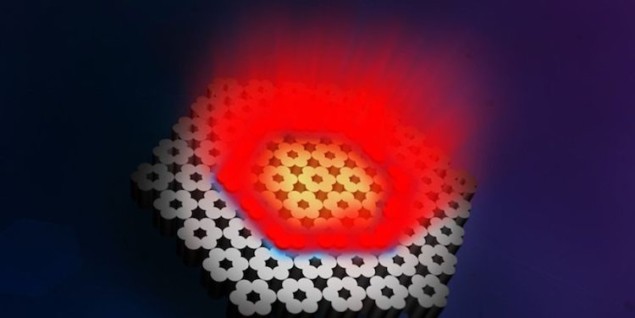Topological insulator design makes 30 lasers emit as one
04 Nov 2021 Isabelle Dumé
An array of 30 vertical cavity surface emitting lasers (VCSELs) has been made to behave as a single coherent light source for the first time, paving the way for large-scale, high-power applications that were previously out of reach for this popular class of laser. The design of the new array draws on concepts from the field of topological insulators, and its developers are now working with industrial partners to refine the technology for use in medical devices and communications networks.
VCSELs are the most common lasers in the world, routinely used in application areas ranging from portable phones and optical communications to instrumentation, manufacturing, sensing and even facial recognition. Like other lasers, they contain a gain medium in which light is generated and emitted. For VCSELs, this gain medium is made from quantum wells or quantum dots and sandwiched between two mirrors that act as a cavity, providing the optical feedback necessary for lasing. The gain medium is also just fractions of a micron thick, giving VCSELs a high switching speed as well as a compact and lightweight construction.
A VCSEL’s small size does, however, strictly limit its output power. Over the last few decades, researchers have sought to increase this power by combining many VCSELs and forcing them to behave like a single laser. The problem is that inevitable imperfections in manufacturing tend to cause the VCSELs to lase in small, independent groups that are not synchronized with the others, making the array’s output incoherent.
Topological photonics
A team led by Sebastian Klembt of the University of Würzberg, Germany and Mordechai Segev of the Technion-Israel Institute of Technology has now found a way to lock the individual VCSELs together. The researchers achieved this by arranging the VCSELs in a geometry that follows some of the concepts of topological insulators – quantum materials that are insulating in their bulk, but excellent conductors of electricity on their surface.
While topological insulators were discovered many years ago, the field underwent a change in 2013 when Segev, Alex Szameit and students at the University of Rostock, Germany demonstrated the first photonic topological insulator. Their work launched a new field of physics, now known as topological photonics.
When the team began working on topological insulator lasers, the research community was sceptical. All lasers require gain, yet at the time, everything known about topological systems was restricted to systems that are Hermitian – that is, exhibiting no gain and no loss. “We were like a bunch of lunatics searching for something that was considered impossible,” Segev recalls.
Locked within a planar structure
In the team’s first photonic topological laser, light travelled around the edges of a two-dimensional array of waveguides without being deflected by defects or disorder in the waveguides. A few years later, Segev and collaborators from the University of Central Florida, Mercedeh Khajavikhan and Demetri Christodoulides, together with their students Gal Harari, Miguel Bandres and Steffen Wittek, demonstrated that they could force many microlasers to lase together and act as single laser. However, this system, described in two Science papers in 2018, had an important limitation: light circulating in the photonics structure was confined to the same plane as the plane required for extracting the light. This meant that the power output of the system was, again, limited by the size of the device.
The new topological insulator VSCEL array consists of two types of honeycomb lattices with a nanoscale pillar at each vertex. The researchers created an interface between honeycombs that are stretched and honeycombs that are compressed. “When you do this with proper parameters, you get a topological interface where the light must flow from one VCSEL to the next,” explains Segev. “This consistent flow of light (in the plane of the chip) – whose flow is topologically protected – forces the light from every laser to reach all the other lasers so that they lock coherently.” The VCSEL arrays therefore emits at a single frequency and displays interference. Crucially, light is now emitted through the surface of the structure from each laser, making it easy to collect.READ MORE

“Our experiments show the power of topological transport of light,” say the researchers, who report their work in Science. “The light spends most of its time oscillating vertically, but the small in-plane coupling is sufficient to force the array of individual emitters to act as a single laser.”
The researchers say the platform they have demonstrated can in principle be scaled up to incorporate hundreds of VCSELs. “We would now like to make such an array into real technology, and have started to work with high-tech industry on this project,” Segev tells Physics World.
FROM PHYSICSWORLD.COM 4/11/2021

Δεν υπάρχουν σχόλια:
Δημοσίευση σχολίου